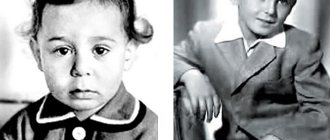"The world seems to be based on money and sex..."
These words belong to Gia Karangi, one of the first American top models and a woman whose life was extinguished in the fight against a terrible illness.
The beginning of her brilliant career was her acquaintance with Francesco Scavullo and Richard Avedon from Vogue and Cosmo magazines. What happened to Gia rarely happens in the modeling business: she rose to world fame fantastically quickly.
Gia Karanjdi on the cover of Cosmopolitan. (wikipedia.org)
One of the most key features of Gia as a model was her amazing face: she could look childishly innocent in one shoot and be the most fatal in other shots. When the agents noticed this, they all predicted her a long life in the modeling business.
Gia Karaji. Source: wikimedia.org
Success was dizzying and for this or some other reason, Gia began to take drugs more often than everyone else around her. In the 70s of the last century, nightclubs and cocaine were practically inseparable. Having quickly conquered the most legendary catwalks of the fashion world, Gia did not notice that her personal life was in a deplorable state.
Last works
It became increasingly difficult to hide my drug addiction. Karanji began to often be late for filming, and sometimes did not show up for work at all. Her behavior was suspicious. She could smile or swear for no reason. Many began to guess the reason for the changes that had occurred in the girl.
One of the issues of Vogue magazine published photographs of the star, where traces of injections on her hands were visible. After the scandalous photo shoot, the agency stopped working with Karanji.
The girl signed a contract with Eileen Ford. But the management did not tolerate this behavior of the model and after 3 weeks refused her services.
In 1982, Gia starred for Cosmo and her photo was featured on the cover. This photograph was her last work.
Career and loneliness
A stunning model, Gia became a muse for photographer Chris Von Wangenheim, who considered Gia's breasts to be the best in modeling at the time. Their fruitful collaboration yielded significant results: Gia’s photographs appeared every now and then on the pages of Vogue magazine, she owned the covers of this magazine in several countries: Great Britain, America and France. Soon, Gia’s figure began to stand out noticeably against the background of other model types, since the bodies of models at that time were shy and homely, and did not compare with her shape.
And despite the fact that the model’s income was huge, and she could afford all the entertainment that existed, Gia spent most of her time alone. On top of everything else, she preferred women. Here is an entry from her diary: “Girls have always been a problem for me. I really don't know why they bother me."
Gia Karadzhi with friends. Source: wikimedia.org
Beautiful and lonely, she wandered around the city, visiting her friends just to hug. It was terribly sad. Gia spent too much time searching not even for her own, but for someone else’s love.
Way down
In 1983, the darkest days came in Gia's life. She lost everything and despite numerous attempts to overcome drug addiction, she could not do it. After another rehabilitation course, Gia tried to start a new life: she got a job as an ordinary saleswoman, signed up for college courses, but it only lasted for a few months.
Another breakdown only intensified her addiction to heroin. In recent years, the former supermodel has led a completely chaotic lifestyle - in desperate attempts to get the next dose.
The beginning of the end of a career
A huge shock for Gia was the news that her mentor and agent, Wilhelmina Cooper, had lung cancer. Heroin helped Jia cope with the stress and fear that suddenly came to her. More precisely, she believed that it would really help. And all the next time she devoted herself to work, unable to refuse those who went crazy about her and dreamed of working with her, as well as the use of that very “magic”.
Wilhelmina died a month after she was diagnosed. And Gia was no longer able to refuse not only filming, but also a new dose. She, like no one, knew that a model should not disappear without a trace, she must be visible, and not get sick, because fashion models do not have such a right. But she began to disappear, behave strangely, and thereby caused rumors that Gia was using drugs. The trouble is that the rumors were not true, Gia became a drug addict.
Childhood and youth
Gia Marie Carangi was born on January 29, 1960 in Philadelphia, USA. Gia was the daughter of the owner of a restaurant chain, Italian Joseph Carangi, and a housewife with Irish and Welsh roots, Kathleen Adams. Carangi has two older brothers, Joe and Michael. One of them talked about Gia’s childhood like this: “She had a small four-poster bed with dolls lying around everywhere. She was just a normal little girl, that’s how I remember her.”
Little Gia Carangi with her mother
Despite the apparent idyll, Gia’s childhood cannot be called cloudless. The family life of the model's parents was turbulent - they constantly argued and quarreled. “Gia and I sat on the steps of the house every evening and listened to them swear. It was terrible,” recalls the girl’s brother. As a result, the marriage fell apart miserably, and in 1971 Kathleen left, leaving the children with her husband, which was a real blow for Gia.
Gia Carangi in her youth
Later, Karanja’s mother was accused of “ruining her daughter’s childhood,” and it was because of her that the girl became addicted to drugs. Relatives recalled that little Gia became a real manipulator and a spoiled child who did not receive enough maternal attention.
Model Gia Carangi
As a teenager, Karangi became completely uncontrollable: she broke curfew, experimented with alcohol, pills and marijuana. Her best friends were the Bowie kids, a group of obsessive fans of musician David Bowie who emulated his “defiantly weird, glamorous” style.
Karanji was interested in the musician not only for his unusual appearance, but also for his ambiguous sexual preferences. Later, one of her friends said that Gia was a real tomboy (tomboy - tomboyish girl, tomboy). Irrepressible sexuality was the only thing Karanji was confident in and of which she was very proud. “She was very open about her intentions. She could easily kiss the person she liked on the lips, grab him and the like,” recalls a friend.
Gia Carangi's famous nude photo shoot
Together with the “Bowie children,” Carangi often went to concerts and hung out in gay clubs in downtown Philadelphia. Gia's behavior upset her mother - she even took her daughter to a psychologist, but this did not help. Then Kathleen decided to keep her daughter busy and invited her to try herself as a model - the schoolgirl had an angelic face and a good figure.
Gia Carangi in Cosmopolitan
However, Karangi found the modeling business himself. In a nightclub, 17-year-old Gia was noticed by Maurice Tannenbaum, who at that time was a hairdresser-stylist and aspiring photographer. Shocked by the girl's beauty, Maurice offered her a free photo shoot. And realizing that he had found a real diamond, he soon took Karangi to New York to introduce her to the whole world. “She was very excited, very nervous, very, very nervous,” Tannenbaum recalls of her first casting at the Wilhelmina Cooper fashion agency.
“Do you want to work with me or not?”
A series of endless meetings and awkward situations began, where Gia looked unsightly; a series of discussions dedicated to her and her problem; a series of breakdowns, interrupted contracts, losses. Tormented by the disease, she enrolled in a rehabilitation program, but did not last long.
After several years of heroin use, the disease went on the offensive: abscesses and ulcers appeared.
A still from the movie “Gia” starring Angelina Jolie. Source: wikimedia.org
At the beginning of 1982, Karangi began to fight again for what belonged to her: for her life. She contacted an agent named Monique Pillade, and their meeting took place in a very tense atmosphere. Monique asked to roll up his sleeves in order to somehow justify his at that time almost criminal desire to work with such a model. “Do you want to work with me or not?” she asked without showing her hand.
Peak of popularity
What caused such a great popularity of a girl named Gia Marie Carangi? Her biography as a supermodel began at the end of 1978, when she first agreed to appear nude. Scandalous photos at that time excited the minds of the public, but no one was going to condemn the girl, since her body was truly beautiful. Just a few months later, photos of the model appeared in almost all fashion magazines. By the way, at that time blondes were especially popular, and Gia, being a bright brunette, stood out from them.
For the first time, the girl began to receive several thousand dollars for filming. In 1979, she was recognized as the owner of the most beautiful “model” breasts, and her photo on the cover of Cosmopolitan was recognized as the best of her entire career. The model's sensuality contrasted nicely with the modesty of the other girls. It was then that Gia Marie Carangi, whose photos were already well recognizable, stopped taking on all orders. Choosing the most interesting and unusual photographs, the model got used to the image and not only showed a beautiful face and body, but pursued the goal of exposing her soul. It was this amazing ability that allowed her to be capricious on set, without fear of scandal or refusal to work with her.
Nothing works out
The opportunity to make a cover for Cosmo magazine appeared on the horizon, and everyone hoped that this would become something epochal, truly culminating, they pinned their hopes on this “return” to the profession. But nothing worked out. What Gia had, her uniqueness, this special spirit, he left her. Hiding her hands and lying to reporters that there were never drugs in her life was terribly difficult. Everything was going downhill. In the spring of 1983, the model was caught with another dose while filming in North Africa. Her career was over.
She moved to Atlantic City and lived there with a girl she met in a rehab program. Gia’s family was preparing for the worst: at any moment they could call and report the death of their favorite: the one who had recently been invited to Europe for a week and promised $10,000, the death of the one who had never found personal happiness, having exchanged it for heroin.
One of the best pictures of Karanja. (wikimedia.org)
Gia ran away, her search lasted quite a long time, periodically she returned, but her life no longer obeyed any rules and patterns: her attempts bore no fruit, nothing worked, and in 1985, when she slept with men for money in order to earn a dose , and was raped several times, Gia ended up in the hospital. Then the preliminary diagnosis was “pneumonia”. She had 6 months left until the end of her life.
After a detailed examination, the diagnosis was changed: Gia was diagnosed with AIDS. Mom did not leave her one step, did not let anyone in, so that rumors and information about her daughter’s illness would not spread. She also did everything to make the ward feel like home and surrounded her daughter with care. But during conversations in the park and walks, they both understood that Gia had no desire to live. And this despite the fact that she regained her faith in God. Gia once asked her mom, “I overdosed three times, why did God save me?” There was no answer.
She wanted to save children who might start taking soft drugs, and make a film in which she would prove by her own example how terrible it is to be addicted to a dose. This was not destined to come true, my physical condition worsened every day, I did not have enough strength for anything.
Gia Carangi died on November 18, 1986. The funeral director advised burying her in a closed coffin, the body was so mutilated.
One of the leading models of the 70s and one of the first supermodels, thanks to whom not only blondes, but also brunettes began to appear on the catwalk. Gia also became the first famous woman in the United States whose cause of death was openly identified as the immunodeficiency virus. In her diary she wrote: “You know, I thank God that I am beautiful; If I look in the mirror and like myself, then I look good.”
One of the first and brightest supermodels of her time, Gia Marie Carangi, would have turned 59 years old today. But in 1986, she died of AIDS-related complications at age 26, becoming one of the first famous women to die from the disease.
Childhood and youth
Carangi was born in Philadelphia, the youngest of three children in the family of Italian Joseph Carangi and Irish Kathleen Carangi (née Adams). Gia's parents had an unstable marriage, accompanied by constant quarrels and showdowns. Ultimately, Kathleen left the family when Carangi was eleven years old. It is with this event that Gia’s constant need for a loved one and her chronic state of loneliness are associated. Relatives remembered her as both a spoiled and shy child who was desperate for her mother's attention.
While studying at high school. Abraham Lincoln Carangi became friends with the "Bowie kids", a group of obsessive David Bowie fans who emulated "defiantly weird, high-fashion glam". In their faces she found the attention that she so lacked. One of Carangi's friends later described her as a "tomboy" with a casual openness about her sexuality. In their free time, Gia and the Beauty Bowies hung out in gay clubs and bars in Philadelphia. Although she was associated with the lesbian community, she did not want to adhere to the "accepted lesbian style."
Modeling career and success
After appearing in several Philadelphia magazines, at the age of 17, Karangi moved to New York. Then everything develops very quickly: she signs a contract with Wilhelmina Models, and her first major shoot, published in October 1978, takes place with the best fashion photographer, Chris von Wangenheim.
On the set she looks absolutely natural and professional, and at the request of the photographer she exposes herself without embarrassment and, unlike other models, is ready to experiment.
At this shoot, she meets makeup artist Sandy Linter - in the future, one of the closest people in Gia's life. Chris von Wangenheim, sensing a special energy between them, invites Sandy to be part of the photo shoot.
Filming behind the fence acquires cult status and opens all doors for Gia.
By the end of 1978, her first year in New York, Carangi was already an established model. Her rapidly growing fame was described by Vogue as "meteoric". Karanji later recalled:
I worked with very good people, I mean from the very beginning, that's why everything happened so quickly. I didn't try to fit in as a model, I just became one of them.
Carangi became the favorite model of the main fashion photographers of the time: Von Wangenheim, Francesco Scavullo, Arthur Elgort, Richard Avedon and Denis Peale were delighted to work with her.
Very soon she finds herself on all four main covers of Vogue: in April 1979, British Vogue; Vogue Paris in April 1979 and August 1980; Vogue US in August 1980 and Vogue Italia in February 1981.
She becomes one of Cosmopolitan's most sought after cover girls between 1979 and 1981.
She has appeared in advertising campaigns for some of the world's most famous fashion houses, including Armani, André Laug, Christian Dior, Versace and Yves Saint Laurent. By the way, at the height of her career, Karangi was known in modeling circles only by her first name.
Drugs, career decline
Despite the success, every day Gia felt a growing sense of loneliness and anxiety. She desperately needed support and love: she often fell in love and was disappointed, and later admitted that it was increasingly difficult for her to trust people, since they needed either sex or money from her. Gia's friend, model Julia Foster, recalled how Gia once came to her only to be hugged by someone.
Despite her close relationship with Sandy Linter, they were not permanent: they came together and then diverged.
A heavy blow was the death of Wilhelmina Cooper in March 1980 - her agent, mentor and one of the few who truly supported Gia sincerely. Devastated, Karangi began abusing cocaine, which she tried while visiting Studio 54 and the Mudd Club, and developed a heroin addiction. Everyone knew about addiction, but preferred to ignore it, since working with it was a real success.
She was still one of the most sought after models until drugs began to directly affect her work. She would lash out, leave the set without warning to buy drugs, or fall asleep in front of the camera. During one of her last shoots for American Vogue, Gia had wounds in the bends of her elbows. Despite the airbrushing, needle marks are visible in some of the photographs published in the November 1980 issue.
Her career ended as quickly as it began. In November 1980, Carangi left Wilhelmina Models and signed a contract with Ford Models, but was fired a few weeks later. The offers soon stop, and friends in the fashion industry, including Sandy Linter, refuse to communicate with her, fearing that it will damage their careers. She returns to Philadelphia to attend rehab.
Attempt to resume career
After several failures, she signs a contract with a new agency, Legends, and works sporadically in Europe. At the end of 1981, although he still struggled with drug abuse, Carangi decided to return to the fashion industry and signed a contract with Elite Model Management.
She participates in the filming of the popular program 20/20, where she claims that she is completely done with drugs and is ready to start life again. In fact, this has little to do with reality.
While some clients refuse to work with her, others are willing to hire her because of her past status as a top model. Scavullo photographs her for the April 1982 cover of Cosmopolitan, her last cover for an American magazine.
What she was doing to herself finally became apparent in the photo... I saw a change in her beauty. There was emptiness in her eyes,” said Sean Byrnes, Scavullo’s assistant.
She shoots primarily for catalogs and department stores, but later appears in an advertising campaign for Versace, shot by Richard Avedon. He hired her for the house's next campaign, but during a photo shoot in late 1982, Carangi became uneasy and left before any successful pictures were taken. Gia's last photo shoot was for the German company Otto Versand in Tunisia: she was sent home mid-shoot due to heroin use. She left New York in early 1983.
Death
In 1984, she again entered an intensive drug treatment program, but in late 1985 she began using drugs again. In December 1985, Gia was hospitalized with double pneumonia. A few days later she was diagnosed with AIDS and related complications. She died on November 18, 1986, at the age of 26. Her funeral took place on November 23 at a small funeral home in Philadelphia. No one from the fashion world attended, mainly because no one knew about her death until several months after her death. Only Francesco Scavullo, Carangi's friend and confidant, sent a condolence card when he heard the news.
Influence
She became one of the most provocative and sensual supermodels of the late 70s and early 80s. She had feminine and masculine energy and skillfully used it on set. Her photo shoots became a sensation and were accompanied by scandals; her ability to transform into any image made her the most desirable model for photographers.
In the year of Gia’s death, the star of Cindy Crawford rose, who at the beginning of her career was called “baby Gia” for her external similarity and versatility.
Gia, like Janice Dickinson, became the harbingers of a new era of supermodels—girls with voluptuous bodies and vibrant personalities who were equally versatile for advertising campaigns and couture shoots, and whose fees approached those of Hollywood.
Gia and Jolie
The story of Gia found new life after the release of the television movie “Gia” in 1998, starring Angelina Jolie. She was completely different from the real Gia, but surprisingly accurately conveyed her voice, habits, and mood, for which she deservedly received a Golden Globe.
The film was at the right time, in the right place and drew attention to the problem of drug addiction in the fashion industry, which was in full swing in the late 90s, and AIDS, which can affect the most talented and most famous.
Author: Nika Egorova
Author of the article: Pink.ua
What can we do now?
On June 5, 1981, the American Center for Disease Control registered a new disease - AIDS (Acquired Immune Deficiency Syndrome).
Today, December 1st, is marked on the calendar for a reason. We need AIDS Day so that we don’t stand still and fight what we can win and support those people who are affected by this problem. The first thing we can do is an HIV test to find out our status and also learn how to protect ourselves and our loved ones from HIV infection. It is also important to know how to speak and write correctly on the topic of HIV infection. The Joint United Nations Program on HIV/AIDS has published specific guidance explaining the concept and terms that are often used in connection with HIV. For example, the difference between “HIV” and “AIDS”, why people cannot be called “victims” and “carriers of AIDS”, and also why the concept of “AIDS virus” does not exist, “standard precautions” that will help not become infected with HIV.
Knowing this and much more, we will be able to help, because language is an important dominant, it forms ideas and, accordingly, can influence human behavior.
Personal life
Gia Karangi’s personal life, despite the girl’s wealth, beauty and popularity, did not work out. Makeup artist Cindy Linter, as well as modeling colleagues Julia Foster and Janice Dickinson, became close friends of the model. According to rumors, these girls were the lovers of Gia, who did not hide her lesbian inclinations.
Perhaps the craving for female society, as well as an attempt to forget in drug intoxication, were the result of a lack of attention from the mother at an early age.
“The biggest mistake we made was that no one accompanied her in New York,” Gia’s brother Michael later admits in an interview.
And Julia Foster will remember:
“She was looking for someone's love, one day Gia came to my house in the middle of the night and I let her in and all she wanted was someone to hold her. It was very sad."











